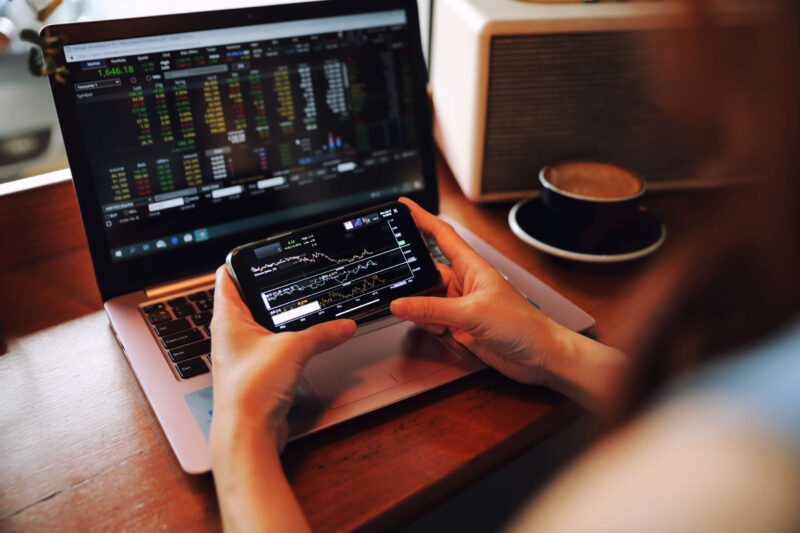For many looking to supplement their income, trading as a side hustle can be appealing. It seems like a quick and straightforward way to grow extra funds. But what does it really take to succeed in this space? Many approach trading with inflated expectations and are met with results that don’t match the reality of the industry. To avoid disappointments, it’s essential to set realistic goals and know what to expect in terms of potential returns.
Key Points
- Set realistic profit goals
- Understand market volatility
- Assess risk tolerance
- Consistent learning is crucial
- Side hustle limitations apply
Realistic Profit Goals

People new to trading often expect immediate high profits. The reality is different. Those serious about trading must recognize that consistent, steady gains are more likely than large, quick wins. This approach allows for sustainable growth over time. Professionals often measure success in percentages, with annual returns ranging between 5% to 20%. Those who chase higher percentages risk making mistakes that lead to losses.
Avoid the mindset that trading can replace a full-time job instantly. It’s more practical to view trading as a supplement to existing income. Consistency, discipline, and patience play a significant role. Anything higher than a 20% return per year typically involves elevated risks, so it’s crucial to evaluate how much risk you are willing to take.
Risk Tolerance and Capital Management
Trading as a side hustle means that you are not dedicating your full time and energy to it, which can be a limiting factor. Assessing personal risk tolerance is key. Many people start with unrealistic expectations of making a profit on every trade. In reality, losses happen frequently, and only those with a clear understanding of how much they are willing to lose will sustain themselves in the long run.
Capital management is another important factor. Even though tools like the Binomo platform allow traders to begin with small amounts, responsible capital allocation ensures that losses don’t impact your finances too heavily. A wise practice is to never risk more than 1-2% of your total capital per trade. Over time, these small risks can add up to more consistent and sustainable gains.
Assessing Risk and Volatility

It’s important to understand that all markets experience fluctuations, and volatility affects the potential for returns. Higher volatility can offer greater profit opportunities, but it also increases the risk of losses. Traders need to factor this into their strategies and risk management.
Many new traders enter the market with low knowledge of volatility. They might think that trading will generate profits every day. In reality, it’s essential to understand that losses are inevitable. No strategy guarantees profits 100% of the time. Recognizing and managing risk can prevent more significant losses and ensure more sustainable returns over time.
The Role of Discipline and Learning
The markets evolve continuously, so strategies must adapt. Novices often think that one successful trade or strategy guarantees consistent success. That’s a common misconception. Only disciplined traders who focus on learning from both successes and failures will improve over time.
Discipline also applies to sticking with a plan. It’s easy to get carried away by emotions, especially when experiencing losses. But emotional decisions often lead to more significant losses. A solid trading plan based on research, analysis, and experience is the best way to achieve consistent returns. Keeping emotions out of the equation is one of the hardest challenges for part-time traders but one that pays off with greater success.
Limiting Factors for Side Hustle Traders

Trading as a side hustle has its limitations. Full-time traders often spend hours researching market trends, analyzing charts, and fine-tuning their strategies. Side hustle traders, on the other hand, have limited time to dedicate to the markets. This difference can make it challenging to keep up with market movements or adapt quickly to shifts in trends.
Side hustle traders must also contend with time-zone differences if they are trading in global markets. For example, the US stock market may open at inconvenient hours for someone working a 9-to-5 job in Europe or Asia. This situation may require flexibility and creativity to balance both regular work and trading.
Realistic Timeframes for Profit
Trading for a few hours a week will not provide the same level of results as dedicating full-time effort. Realistically, side hustle traders should expect slower growth in returns compared to those who trade full-time. Over the course of a year, a 5%-10% return can be considered a reasonable goal for someone with limited time to devote.
Part-time traders should approach trading with a long-term mindset. The market fluctuates daily, but focusing on quarterly or annual returns helps traders remain patient and stick to their strategies. Constant monitoring of returns isn’t necessary, and in many cases, taking a step back can lead to better results.
Conclusion

Trading as a side hustle offers potential returns, but only for those who enter with realistic expectations. Consistent learning, careful risk management, and disciplined strategies are key to success. While full-time traders might have more time to devote to researching and analyzing markets, part-time traders must adjust their expectations and approach.
Starting with small amounts and managing risks is vital. Many platforms allow new traders to test strategies with minimal investment, enabling them to build experience without taking on excessive financial risks. Those who understand market volatility, set clear goals, and stay disciplined will find trading a valuable side hustle, but it is not a path to quick or guaranteed profits. Instead, a steady, consistent approach yields the best long-term outcomes.


